Inclusive Higher Ed: Academic Libraries Serving Nontraditional Students
Current students are likely to begin their postsecondary education at age 22 or far older. They may be the first members of their families to attend college. They may be recent immigrants or English-language learners. They may be career changers or veterans. They may be incarcerated. And, as many institutions are discovering, academic libraries are uniquely positioned to meet their needs.
Academic libraries are flexing to meet the needs of nontraditional students
As postrecession college enrollment continues to climb, student demographics skew ever further from the “traditional” undergraduate—the 18- to 22-year-old who enrolls immediately after high school or a single gap year, attends class full-time, lives on campus, is funded by parents or guardians, and graduates in four years. Current students are likely to begin their postsecondary education at age 22 or far older. They may be the first members of their families to attend college. They may be recent immigrants or English-language learners. They may be career changers or veterans. They may be incarcerated. And, as many institutions are discovering, academic libraries are uniquely positioned to meet their needs.
No matter what their particulars, nontraditional students—defined by the U.S. Census Bureau as those who are over the age of 22, attending school less than full-time, often with families or dependents, and often with full-time employment—have a new range of requirements. Many of these are clear areas for library involvement. The growing adoption of distance learning by students who work days or are not within commuting distance of their school means that libraries need to work with instructors to help provide remote access to materials and resources; libraries are increasingly involved in the development of class content as well. Even in-person students often attend classes on nights or weekends due to work or caregiving schedules, and need access to course reserves and answers to questions.
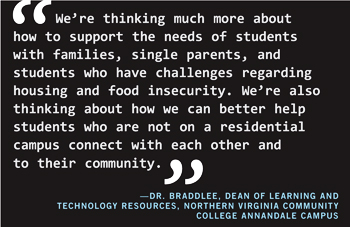 But the academic library’s role in serving nontraditional students is evolving beyond those core services. Options for managing college costs, assistance in academic preparedness and navigating college life, and even access to social services are moving into the library’s purview as it is increasingly acknowledged as one of the critical centers—both physical and virtual—of campus life.
But the academic library’s role in serving nontraditional students is evolving beyond those core services. Options for managing college costs, assistance in academic preparedness and navigating college life, and even access to social services are moving into the library’s purview as it is increasingly acknowledged as one of the critical centers—both physical and virtual—of campus life.
CCLASSS WORK
As the nontraditional student becomes more of a staple of an institution’s enrollment and graduation numbers, the overarching concept of “student success” needs to move beyond traditional institutional metrics of retention and graduation. Many innovations that have found their way to the library are being led by community colleges, which have typically attracted students outside the traditional four-year mold for a variety of reasons—chief among them cost and course flexibility.
ITHAKA S+R’s multiphase Community College Libraries and Academic Support for Student Success (CCLASSS) project, funded by a grant from the Institute of Museum and Library Services, has taken on a multi-year mission of examining student goals, challenges, and needs in order to explore how community colleges and their libraries can work together to serve them.
In spring 2018, CCLASSS conducted an initial round of interviews with students at seven partner community colleges across the United States. The resulting report, Amplifying Student Voices, revealed that students’ definitions of success centered not only on career and educational achievement but on personal development and enrichment, and that they faced significant challenges around balancing work and school, finances, child care, language barriers, transportation to and from campus, and navigating college resources and services.
Using the responses from those interviews as a starting point, the CCLASSS team developed a series of new service prototypes that could be implemented in libraries to help these students. Feedback on the prototypes was collected via surveys with nearly 11,000 student respondents; all of the partner colleges will be implementing one or more of the services, and CCLASSS will be issuing a report on its findings later in the fall.
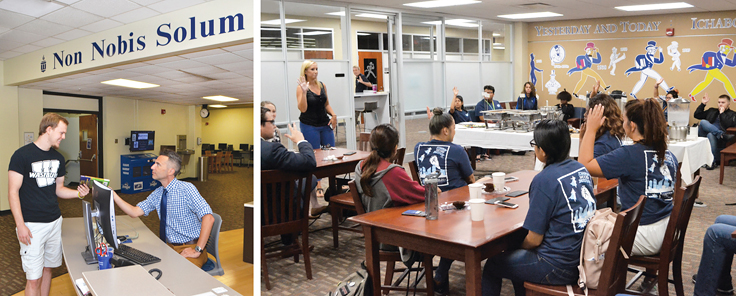 |
REBUILT FOR SUCCESS Washburn University’s renovated Mabee Library houses a range of student success services. Left: an inviting welcome desk encourages students to ask for what they need; right: a gathering in the Ichabod Reading Room, a former third-floor study lounge. Photos courtesy of Washburn University |
One significant point students made, says ITHAKA Manager of Surveys and Research Christine Wolff-Eisenberg, was that they often had a difficult time navigating information related to college—not necessarily when it came to course work, but rather what office to go to for a particular service, or what to do when they ran up against institutional red tape. They would be particularly well served by a single point of entry to help them connect the dots between services, and the library is an ideal location for it. Part of the project’s mission, she adds, is raising awareness of that capacity. “I don’t know that others in the college think about the library in quite that way, as potentially the connecting piece between all of these other service providers,” Wolff-Eisenberg says.
“College organizations often have tracks for things like holistic student support, and that encompasses most of what’s in student affairs [offices],” she notes, “and then they have the teaching and learning side…which is mostly what’s thought of as what happens in the classroom. The library gets lost between these two, because it’s very much serving both directions, but doesn’t necessarily neatly fit into one of the categories.”
While not every library has the space to incorporate new offices or services, and the CCLASSS team has not yet surveyed librarians, Wolff-Eisenberg believes it may be a natural fit, saying, “I suspect librarians who sit at a public-facing desk are [already] approached all the time for information about other areas of the institution.”
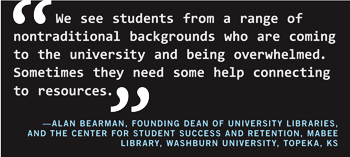 PARTNERING FOR STUDENT SUCCESS
PARTNERING FOR STUDENT SUCCESS
Academic libraries serving nonstandard student populations would do well to look to their public counterparts, says Dr. Braddlee, dean of learning and technology resources for the Northern Virginia Community College (NOVA) Annandale Campus, one of the CCLASSS project’s main academic partners. The college population is representative of the full spectrum of community members—“the top 100 percent of all students that apply,” he laughs—and, much like a public library, libraries like NOVA’s are subject to resource and staffing constraints as funding fluctuates.
Braddlee’s students, too, are struggling, and his library’s concerns “go beyond information literacy, research, and access to resources,” he says. “We’re thinking much more about how to support the needs of students with families, single parents, and students who have challenges regarding housing and food insecurity. We’re also thinking about how we can better help students who are not on a residential campus connect with each other and to their community.”
NOVA is a majority-minority institution, with 72,000 students from more than 180 different countries, many of them first-generation students or new Americans. “One of the things we’re trying to understand better is how these students, who come to us by these different pathways, understand libraries, librarians, and librarianship,” says Braddlee.
The students Braddlee sees are often stretched to meet their basic needs on top of finding the financial resources to continue their education. The library has begun partnering with the college’s One-Stop Student Services to raise the visibility of the resources it offers, such as the Financial Stability Center. One-Stop Student Services, relatively new at the college, “are small but mighty,” says Braddlee. Rather than duplicate what they offer, the library will “serve as a force multiplier for the work they’re doing”—for example, offering displays and events on One-Stop as part of its Back to School initiative this fall.
STUDENT SERVICES MOVE TO THE LIBRARY
Washburn University in Topeka, KS, recently decided to move student services directly into its library. Some 50 percent of Washburn students are the first in their families to attend college, and 60 percent are not prepared, according to Alan Bearman, founding dean of University Libraries and the Mabee Library’s Center for Student Success and Retention.
When the library underwent a reorganization in 2012, the administration chose to migrate student success initiatives and offices into the library, and it has continued to build them out there. These changes arose “somewhat organically” during the process of revising student learning outcomes, Bearman recalls. It was clear that many of Washburn’s diverse array of students needed more academic help; the administration narrowed the university’s list of outcomes from nine to four and added one: information literacy, which was positioned as the focus for all student success programs.
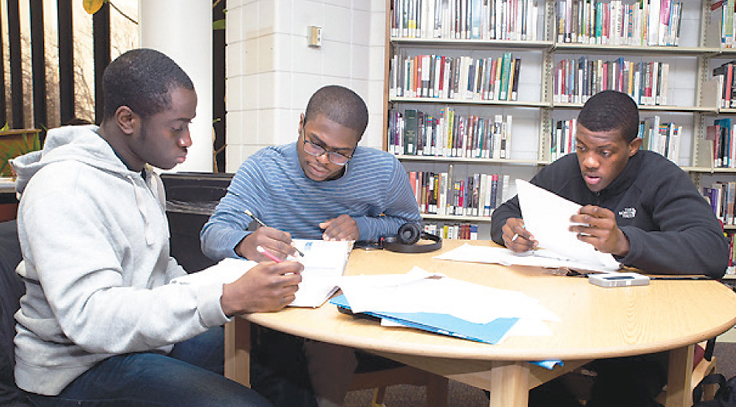 |
SUPPORT WHERE IT MATTERS Students at Northern Virginia Community College’s Alexandria Campus Library have access to a full range of student support in addition to traditional library services. Photo courtesy of Northern Virginia Community College |
“So it naturally evolved that the library was going to play this central role in all the activities,” says Bearman. All staff—except the university archivist—are instructional librarians now. Thanks to interlibrary loan from the neighboring University of Kansas and Kansas State University, the need to focus on collections is increasingly less pressing. “That was a big shift,” says Bearman, “but for the most part our librarians embraced it.”
Services housed in the library include a first-generation-student specialist; the Military-Student Success Center, serving military dependents and military-affiliated students (on active duty, reserve, or National Guard status or in ROTC) as well as veterans; the Center for Prior Learning and Testing, which evaluates students’ past and experiential knowledge toward college credits; academic advising; the academic recovery program for students on academic probation or warning; first-year student success activities and oversight of the school’s first-year seminar; and, taking a cue from the local high school—which provides many of Washburn’s students—a social worker.
“We see students from a range of nontraditional backgrounds who are coming to the university and being overwhelmed,” says Bearman. “Sometimes they need some help connecting to resources.” Bearman had thought the social worker would see 20 to 25 students a semester; he sees that many a week. The social worker’s library location also serves to take some of the stigma away from visiting his office, as no one has to know students are going for help.
The library has also built several bridge programs with the local high school to reach those students before they get to college. “We’ve done a good job partnering with high school librarians and counselors, trying to identify students who will go to Washburn and build pathways for them to help them transition successfully,” says Bearman. “The sooner we can get to the students and the more we can do with them early, the better the outcomes are.”
Other accommodations for nontraditional students in the physical space of the library include, for parents, partnering with child care programs on campus and providing family-friendly spaces where children can play with toys while their caregivers study or do research. Libraries can also provide quiet spaces friendly to veterans who may be grappling with PTSD.
ASKING THE RIGHT QUESTIONS
As part of the library’s pipeline to student support, Braddlee works to help library faculty and staff learn how to begin critical conversations with students who need help in order to connect them with those who can get them the proper resources.
If this sounds like a student services variation on a traditional reference interview, it is. When working with nontraditional students in the library setting—both for student service referrals and traditional library advising—it’s critical that staff not make assumptions or fall back on stereotypes. Reference interview techniques are valuable for finding out students’ skills and comfort levels.
For example, says Nicole A. Cooke, Augusta Baker Endowed Chair and associate professor at the University of South Carolina’s School of Library and Information Science, older students are often assumed to have less knowledge of computers and the Internet, but that’s often not the case. Many returning students are changing careers, coming with a wealth of experience from a previous field, says Cooke, “and they want that recognized and valued.”
Cooke, the author of “Becoming an Andragogical Librarian: Using Library Instruction as a Tool to Combat Library Anxiety and Empower Adult Learners” (New Review of Academic Librarianship, 2010), believes that adult education is a skill set of its own. Andragogy—as opposed to pedagogy, which traditionally focuses on younger students—is theory specific to teaching adults.
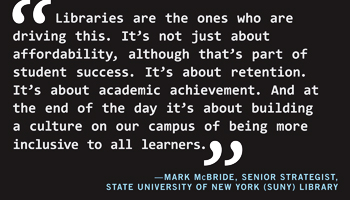 When she started out as an academic librarian at Montclair State University, NJ, recalls Cooke, she would be in the library during the 3–11 p.m. shift and weekends. “I was getting the folks who were working full shift and then coming back to school at night—the veterans, the caregivers, those who are not necessarily going to school during the day.” Her interactions got her thinking about what library workers needed to know about working with those groups, and how they differed from younger students.
When she started out as an academic librarian at Montclair State University, NJ, recalls Cooke, she would be in the library during the 3–11 p.m. shift and weekends. “I was getting the folks who were working full shift and then coming back to school at night—the veterans, the caregivers, those who are not necessarily going to school during the day.” Her interactions got her thinking about what library workers needed to know about working with those groups, and how they differed from younger students.
While she cautions against pigeonholing any group, Cooke has found a few constants. Older learners don’t want to be lectured to, she notes, and they generally prefer hands-on, practical learning using the subjects they’re working with as examples. “Adult learners are paying for their own education,” she points out. “They want it to be as relevant as possible.” Library workers should be prepared with neutral questions to help assess skill level in a respectful, non-threatening way.
Cooke also points to library anxiety as a potential barrier to service—a phenomenon present across all age groups, but frequent among nonstandard students, who are often susceptible to feelings of being an outsider or lacking common knowledge. “It could be because they don’t want someone else to think they’re asking a stupid question, or they don’t want someone to say to them, ‘You should already know that,’” she says. Older students, first-generation students, or English-language learners often wrestle with anxiety when asking for help.
Stereotype threat can also deter nontraditional students of color, or those from marginalized communities, from seeking assistance. Cooke offers the example of some Asian students not wanting to ask for assistance with a math question because they are afraid that the librarian will assume they should already know the answer.
That’s why it’s important, she says, to provide multiple ways of asking for assistance, including options for students to get information on their own. Some are comfortable asking in person, but others prefer to phone, chat, or text. As a librarian, Cooke created a virtual library tour for incoming students so that they wouldn’t have to feel uncomfortable asking where the bathroom was, or where the science books were shelved.
AFFORDABILITY EQUALS RETENTION
Many of the challenges facing nontraditional students are concrete: time, money, transportation, and access to materials. Textbook affordability has become a rallying cry at many schools, from Columbia University’s First-Generation Low-Income Partnership (FLIP)—a collection of textbooks and course materials that qualifying students at Columbia College and Barnard College can check out for a semester—to pushes to develop free or low-cost open educational resources (OER).
OER initiatives are usually instituted by departments, or occasionally institution-wide. In 2011, however, the entire 64-campus State University of New York (SUNY) system repurposed extra funding toward grants for innovative approaches to teaching and learning—and saw a flood of applications for OER development, much of it driven by campus libraries. This grassroots momentum got the attention of New York State officials; in 2017 the state legislature put $8 million on the table for OER development, to be split evenly between SUNY and the City University of New York, which were tasked with helping build OER initiatives.
 Initially, says SUNY Library Senior Strategist Mark McBride, interest in OER was about getting textbooks into students’ hands. But faculty discovered that students using open materials were showing a higher rate of class completion. “Adult learners were the ones who struggled the most with paying for textbooks, because they have other responsibilities outside their education,” says McBride. “But OER also keeps students in the seats. We’re giving them the keys to complete their coursework.” In turn, he adds, involvement with the development of course materials gave faculty more insight into how nontraditional learners were engaging with the content.
Initially, says SUNY Library Senior Strategist Mark McBride, interest in OER was about getting textbooks into students’ hands. But faculty discovered that students using open materials were showing a higher rate of class completion. “Adult learners were the ones who struggled the most with paying for textbooks, because they have other responsibilities outside their education,” says McBride. “But OER also keeps students in the seats. We’re giving them the keys to complete their coursework.” In turn, he adds, involvement with the development of course materials gave faculty more insight into how nontraditional learners were engaging with the content.
“Libraries are the ones who are driving this,” says McBride. “It’s not just about affordability, although that’s part of student success. It’s about retention. It’s about academic achievement. And at the end of the day, it’s about building a culture on our campus of being more inclusive to all learners.”
One of the SUNY system’s primary OER partners, Lumen Learning, builds both in-person and distance content specifically geared toward adult learners and first-generation students, notes McBride. Materials often include personalized learning experiences and periodic self-checks. “If they can [work] at their own pace and have their own moments of reflection,” says McBride, the learning experience “builds a little more belief in themselves and makes them better intrinsic learners.”
NOVA is also working on an affordable material development project in partnership with the Virtual Library of Virginia, as well as adopting a college-wide OER policy. In addition to sustainable savings—Braddlee points to a recent survey in The International Review of Research in Open and Distributed Learning in which 42.2 percent of student respondents said they reinvested the money saved by using OER into their education—OER materials licensed to the library help it track enrollments and outcomes for the students who use them.
The spaces in which academic libraries can make a difference to the changing higher education student body are many and varied. Administrators and librarians are stepping up their interest in addressing nontraditional student needs, and as a variety of organizations examine the landscape and suggest innovations, these changes will continue to ensure a robust education for all.
RELATED
ALREADY A SUBSCRIBER? LOG IN
We are currently offering this content for free. Sign up now to activate your personal profile, where you can save articles for future viewing









Add Comment :-
Comment Policy:
Comment should not be empty !!!